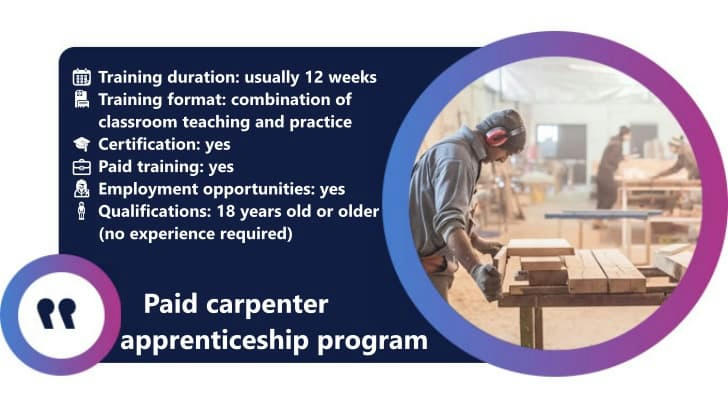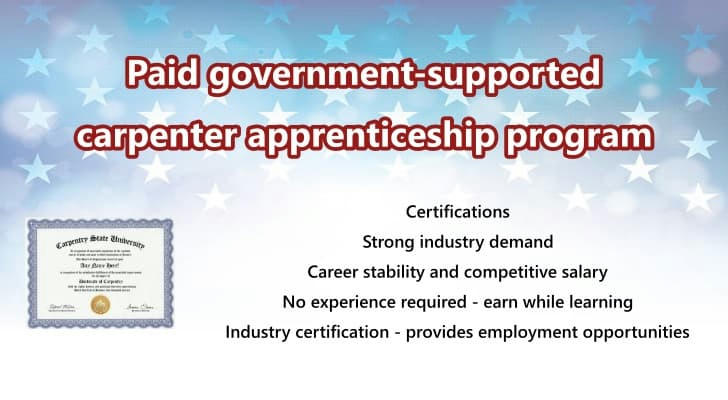Earn While You Learn – Government-Supported Carpentry Apprenticeship
No experience needed | Over 18 years old | 12-week training | Certification provided
In today's rapidly changing job market, hands-on skills are more valuable than ever. The carpentry industry has stood the test of time. Whether it is residential, commercial construction or fine carpentry, skilled carpenters are in high demand everywhere. For those seeking a stable and fulfilling career, government-supported carpentry training programs may be a great opportunity to not only build houses, but also create a better future.

What is government-supported paid carpentry training?
Government-supported carpentry training programs are short-term, skill-based courses designed to provide ambitious but inexperienced people with the practical knowledge they need to enter the workplace. These trainings are supported or subsidized by state or federal governments and are very friendly to qualified applicants. In many cases, participants will even receive a stipend or hourly wages during the program, so this is a paid training opportunity.
The course usually lasts 12 weeks, depending on the location and specific course. At the end of the program, participants will receive a recognized certificate, which will enhance their employment prospects and may even lead directly to full-time employment.
Why choose government-supported paid carpentry training?
1. Strong industry demand
Carpentry is in high demand nationwide. According to the U.S. Bureau of Labor Statistics (BLS), employment of carpenters is expected to grow by 4% from 2023 to 2033, with approximately 76,500 carpenter job openings each year.
2. Career stability and competitive compensation
The average annual salary for carpenters is between $60,000 and $70,000 , and experienced professionals can earn more than $95,000 .
3. No experience required – earn while you learn
No experience is required to participate in this training program. Participants can earn $15.16-25.18 per hour while studying. This program allows you to gain professional skills while earning a stable income.
4. Industry certification - provides employment opportunities
After completing the government-supported apprenticeship, you will receive an apprenticeship completion certificate issued by the United Council of Carpenters (UBC) and be offered a paid on-the-job position. Students will also receive other industry-recognized qualifications.
Who Can Apply?
Most programs require participants to hold a high school diploma or GED equivalent. No prior construction experience is usually necessary — the courses are designed for beginners. What matters most is a willingness to learn, work hard, and show up every day ready to gain a practical skill set.
These programs are open to:
High school graduates looking for alternatives to college
Unemployed individuals seeking retraining
Veterans entering the civilian workforce
Formerly incarcerated individuals reintegrating into society
Adults pursuing a career change into the skilled trades
What Will You Learn?
Carpentry training programs combine classroom instruction with hands-on practice. Coursework typically includes:
Basic carpentry tools and safety procedures
Blueprint reading and measuring
Framing, roofing, and drywall installation
Material selection and use
Interior and exterior finishing
Construction site safety (may include Occupational Safety and Health Administration (OSHA) certification)
Some programs also include life skills training, such as interview preparation, resume building, and financial literacy—giving graduates the best chance of getting and keeping a job.
How to apply for government-supported paid carpentry training?
1. Workforce Innovation and Opportunity Act (WIOA)
Eligible groups: unemployed, low-income workers, veterans and those seeking a career change.
How to Apply: Visit the CareerOneStop website or contact your local American Job Center (AJC) to apply for financial assistance for carpentry training.
2. Registered Apprenticeship (RA)
Features: Offered by an employer or trade association, it combines paid on-the-job training with classroom instruction.
Find a course: Search "carpentry apprenticeship" on Apprenticeship.gov.
3. Industry Partner Program
If you are interested in carpentry skills training, UBC's Carpenters International Training Center is a world-class training facility designed to enhance students' skills and career development.
4. Veteran Resources
GI Bill Benefits
The GI Bill, issued by the U.S. Department of Veterans Affairs (VA), allows veterans and their spouses or children of active duty military personnel to receive carpentry training. GI Bill funds can be used to pay for apprenticeship programs, vocational training, and certification exams, and provide a living stipend.
Tuition and exam fees are covered, and some programs also provide housing assistance (Monthly Housing Allowance, MHA).
Available to veterans, active duty military personnel, and their families.
Can be used at community colleges, carpentry schools, or apprenticeship programs.
Apply through their official website.
How to apply and start your career as a carpenter?
Choose a course: Research different paid training programs and choose the one that suits you.
Prepare application materials: ID card, graduation certificate, etc.
Submit application: Submit application form according to program requirements.
Confirm registration: After receiving the confirmation email, prepare to start the course.
Start learning: Complete training, get certified, and start a high-paying career!
Real Success Stories
James R., 28, from Detroit, was unemployed for nearly a year after being laid off during the pandemic. He then applied for a paid carpentry training program that paid weekly wages. Within three months, he received a job offer from a construction company with a starting salary of $22 per hour.
Maria L., 34, a single mother from San Antonio, said she didn't want to go back to college. The 12-week carpentry course gave her confidence, skills and income. She now works full-time and is saving to buy her first home
Stories like this are becoming more and more common as cities and states increase their investment in skilled trades and workforce development.

Government-supported paid woodworking training: A path to new opportunities
A career in woodworking doesn’t require a four-year degree. It requires motivation, self-discipline, and the right opportunities—and that’s what government-supported training programs are currently offering. If you’re ready to take control of your future, earn while you learn, and create something meaningful, consider enrolling in a paid woodworking training course near you. The need is real, the benefits are visible, and the future is bright.
